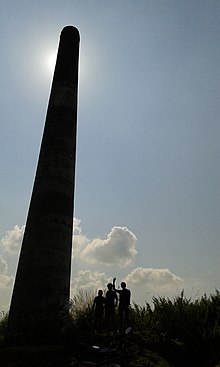
A brickfield is a field or other open site where bricks are made.[1] Land may be leased by an owner to a brickmaster, by whom the manufacture of bricks may be conducted.[2] Historically, the topsoil was typically removed and the clay beneath was stripped and mixed with chalk and ash to make bricks.
In pre-19th-century England, [i]n most areas the brickfield owner hired a brickmaster at a price per thousand bricks to superintend the site and take full responsibility for the output of the operations. He in turn contracted with moulders to temper, mould and hack the bricks. Each moulder then hired his own 'gang' of subsidiary labourers and acted as their employer.[3]
Subsequently, the field (if not too damaged ecologically)[4][5] could be used for horticulture. In Kent such fields were often planted with fruit trees. Brickfields were mainly created from 1770 to 1881,[citation needed] when a new shaly clay was discovered at Fletton. This period coincided with the housing and railway boom in London and cheap river-transport in Thames sailing barges. Brickfields existed elsewhere, but often the clay layer was deeper or there was no chalk nearby.[6] In modern times bricks are made at a brickworks.
"Brickyard" can serve as a synonym of "brickfield".[7]
Brickfield or Brickfields became a common place name in southeast England.
- ^ "brickfield". Oxford English Dictionary (Online ed.). Oxford University Press. (Subscription or participating institution membership required.)
- ^
Bainbridge, William; Brown, Archibald (1900). "Freehold Lands: Mines Within and Under". The Law of Mines and Minerals: With an Appendix of Mining Precedents, Fully Annotated with References to the Text. And a Glossary of English Mining Terms. Legal classics library (5 ed.). London: Butterworth & Company. p. 19. Retrieved 22 December 2022.
The lease of a brickfield (or of a field containing brick-earth), with liberty to get and carry away the clay and to manufacture it into bricks, is a valid enough lease; and the lessee may even exhaust the field, subject (where the lease so provides) to his afterwards levelling the field; but the lessor must be shown to have such an estate in the lands as warrants the lease, or else to have a power to make such a lease; and if the lease is merely of certain premises (portion of which is a field containing brick-earth), the lessee may not dig or take the earth, - much less may he exhaust the field of all the clay, - not even when the lease purports to be without impeachment of waste [...]. Bishop of London v. Web (1718), 1 P. Wms. 527.
- ^ Watt, Kathleen Ann (September 1990). "2.1: The Traditional Brickmaking Industry". Nineteenth Century Brickmaking Innovations in Britain: Building and Technological Change (PDF) (Doctor of Philosophy). University of York: The Institute of Advanced Architectural Studies. Retrieved 16 December 2022.
- ^
2012 Clean Energy Investments: Project Summaries. Clean Energy Investments Project Summaries. Mandaluyong City: Asian Development Bank. 2013. ISBN 9789292540159. Retrieved 16 December 2022.
High energy intensity from growing inefficient industrial operations is a major contributor to greenhouse gas emissions and fine particulate pollution in Bangladesh. Brickfields are among the largest industrial polluters.
- ^
Your Environment. Vol. 1–2. Your Environment. 1970. Retrieved 16 December 2022.
The government's definition of derelict land must be broadened to include those coal dumping grounds and brickfields which for technical reasons now escape the definition.
- ^ Pearce & Long 1987.
- ^
Schäfer, Martin (22 January 2018) [2017]. The semantic transparency of English compound nouns. Volume 3 of Morphological investigations. Berlin: Language Science Press. p. 278. ISBN 9783961100309. Retrieved 16 December 2022.
brick yard [...] 'brickyard n. a place where bricks are made, a brickfield.'